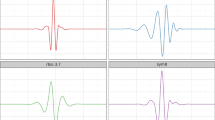Abstract
Wavelet moment invariants are constructed for object recognition based on the global feature and local feature of target, which are brought for the simple background of the underwater objects, complex structure, similar form etc. These invariant features realize the multi-dimension feature extraction of local topology and invariant transform. Considering translation and scale invariant characteristics were ignored by conventional wavelet moments, some improvements were done in this paper. The cubic B-spline wavelets which are optimally localized in space-frequency and close to the forms of Li’s (or Zernike’s) polynomial moments were applied for calculating the wavelet moments. To testify superiority of the wavelet moments mentioned in this paper, generalized regression neural network (GRNN) was used to calculate the recognition rates based on wavelet invariant moments and conventional invariant moments respectively. Wavelet moments obtained 100% recognition rate for every object and the conventional moments obtained less classification rate. The result shows that wavelet moment has the ability to identify many types of objects and is suitable for laser image recognition.
Similar content being viewed by others
References
Chua K, Arshad M R. Robotics vision-based heuristic reasoning for underwater target tracking and navigation [J]. International Journal of Advanced Robotic Systems, 2005, 2(3): 245–250.
Cufi X, Garcia R, Ridao P. An approach to visionbased station keeping for an unmanned underwater vehicle [C]//Proceedings of the IEEE/RSJ International Conference on Intelligent Robots and Systems. EPFL, Lausanne, Switzerland: IEEE, 2002: 799–804.
Kinsey J C, Eustice R M, Whitcomb L L. A survey of underwater vehicle navigation: Recent advances and new chanllenges [C]//Proceedings of the 7th IFAC Conference on Maneuvering and Control of Marine Craft. Lisbon, Portugal: IFAC, 2006: 1–12.
Hu M-K. Visual pattern recognition by moment invariants [J]. IRE Transactions on Information Theory, 1962, 8(1): 179–187.
Li Y J. Reforming the theory of invariant moments for pattern recognition [J]. Pattern Recognition, 1992, 25(7): 723–730.
Teague M R. Image analysis via the general theory of moments [J]. Journal of Optical Society American, 1980, 70(8): 920–930.
Belkasim S O, Shridhar M, Ahmadi M. Pattern recognition with moment invariants: A comparative study and new results [J]. Pattern Recognition, 1991, 24(12): 1117–1138.
Tang Xu-dong, Zhu Wei, Pang Yong-jie, et al. Target recognition system based on optical vision for AUV [J]. Robot, 2009, 31(2): 171–178 (in Chinese).
Shen D, Ip H H S. Discriminative wavelet shape descriptors for recognition of 2-D patterns [J]. Pattern Recognition, 1999, 32(2): 151–165.
Wang Xiang-yang, Yang Yi-ping, Yang Hong-ying. A new robust digital image watermarking based on wavelet moments [J]. Journal of Image and Graphics, 2010, 15(1): 15–19 (in Chinese).
Zhang Tie-zhu, Jiang Hong. Intelligent target recognition based on the data fusion of radar and infrared imaging sensor [J]. Infrared and Laser Engineering, 2010, 39(4): 756–760 (in Chinese).
Zhu Guang-tao, Li Ying. License plate character recognition method based on wavelet moment and principal component analysis [J]. Computer Systems Application, 2012, 21(7): 168–171 (in Chinese).
Zhang He, Xu Yu-ru, Wan Lei, et al. Processing method for underwater degenerative Image [J]. Journal of Tianjin University, 2010, 43(9): 827–833 (in Chinese).
Wang Yi-feng, Liu Zhi-shen. A denoising method for underwater laser image based on mathematical morphology [J]. Electro-Optic Technology Application, 2006, 21(3): 51–53 (in Chinese).
Erkmen B, Yildirim T. Improving classification performance of sonar targets by applying general regression neural network with PCA [J]. Expert Systems with Applications, 2008, 35(1–2): 472–475.
Parojčić J, Ibrić S, Djurić Z, et al. An investigation into the usefulness of generalized regression neural network analysis in the development of level A in vitro-in vivo correlation [J]. European Journal of Pharmaceutical Sciences, 2007, 30(3–4): 264–272.
Author information
Authors and Affiliations
Corresponding author
Additional information
Foundation item: the Fundamental Research Funds for Central Universities (No. HEUCF110111), the National Natural Science Foundation of China (No. 51009040), the China Postdoctoral Science Foundation (No. 2012M510928), the Heilongjiang Postdoctoral Fund (No. LBH-Z11205), and the National High Technology Research and Development Program (863) of China (No. 2011AA09A106)
Rights and permissions
About this article
Cite this article
Huang, Sl., Pang, Yj., Wang, B. et al. Wavelet moment invariants extraction of underwater laser vision image. J. Shanghai Jiaotong Univ. (Sci.) 18, 712–718 (2013). https://doi.org/10.1007/s12204-013-1454-6
Received:
Published:
Issue Date:
DOI: https://doi.org/10.1007/s12204-013-1454-6
Key words
- wavelet moment invariants
- underwater optical vision images
- underwater laser imaging
- feature extraction
- object recognition




